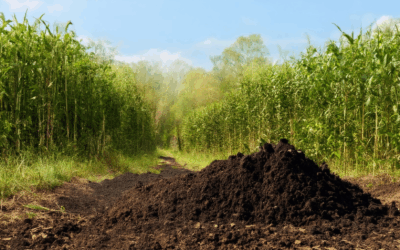As the world increasingly turns toward sustainable solutions to combat climate change and promote eco-friendly practices, renewable biochar systems have emerged as a fascinating and versatile technology. These systems, designed to convert organic waste into a stable carbon-rich material, offer a promising avenue for reducing greenhouse gas emissions while enhancing agricultural productivity. However, the debate surrounding biochar remains lively, with questions about its renewability, environmental impact, and practical applications frequently asked. In this comprehensive exploration, we delve into the intricacies of renewable biochar systems, examining their benefits, challenges, and potential to revolutionize sustainable farming practices.
Key Takeaways
– Biochar Sequesters 1.5 to 2.5 Tons of CO2 Per Ton, making it a powerful tool for carbon capture and contributing to climate mitigation.
– Biochar Enhances Soil Carbon by improving organic matter and adsorbing CO2, supporting sustainable farming practices.
– Sustainable Farming Benefits: Biochar reduces greenhouse gas emissions and improves soil health, aligning with eco-friendly agricultural methods.
– Seamless Integration: Biochar systems can easily fit into existing farming routines, offering a scalable solution for carbon sequestration.
– Distinct from Charcoal: Unlike traditional charcoal, biochar is specifically designed for agricultural use, enriching soil and promoting biodiversity.
– Eco-Friendly Impact: Biochar supports sustainable farming by locking carbon away and enhancing soil fertility without harmful byproducts.
– Research-Backed Potential: Farmers should explore biochar’s benefits and optimal application methods for maximum effectiveness, supported by scientific evidence.

Why is Biochar Controversial?
Biochar, a blackened charcoal produced through the pyrolysis of organic materials, has gained attention for its potential as a carbon sequestration tool. However, its popularity is clouded by several controversies:
- Production Variability: The lack of standardized regulations in many regions leads to inconsistent quality and efficacy of biochar. While some areas, like parts of Europe, have strict controls, others may produce biochar with varying compositions, impacting its effectiveness and safety.
- Land Use Conflicts: The high demand for biomass to produce biochar can conflict with traditional agricultural practices, potentially diverting land from food production or ecological preservation, sparking debates over land use priorities.
- Carbon Sequestration Claims: Critics argue that the carbon sequestration benefits of biochar are often overstated. Questions remain about the extent and accuracy of these claims, particularly due to inconsistencies in measurement methods and reporting standards.
- Environmental Concerns: The production process can release pollutants if not conducted efficiently, raising environmental and public health issues. This has led to concerns about local air quality and ecosystem impacts.
- Soil Health Impact: While biochar is promoted as a soil amendment, there are ongoing discussions about its long-term effects on soil health. Mixed scientific findings contribute to debates among experts and enthusiasts.
- Regulatory Challenges: A lack of unified regulations makes it difficult for producers to ensure product quality and safety, deterring investment and consumer confidence in biochar products.
- Economic Uncertainties: High production costs and fluctuating market demands challenge biochar’s sustainability, leading to skepticism about its long-term viability as a viable solution.
These multifaceted issues highlight the complexities surrounding biochar, contributing to its controversial status among various stakeholders.
Is Biochar Renewable?
Yes, biochar is considered a renewable resource. It is produced through the process of pyrolysis, which converts organic materials, such as agricultural waste or forestry residues, into a carbon-rich material. This process typically uses heat and limited oxygen, making it efficient and sustainable when utilizing renewable energy sources like biogas or solar power.
One of the key advantages of biochar is its ability to act as a soil amendment, enhancing agricultural productivity and promoting carbon sequestration. By incorporating biochar into the soil, it helps store carbon, which contributes to mitigating climate change. This circular approach supports sustainable land management and food security, making biochar a valuable component in renewable energy systems.
While the production of biochar may require energy, integrating it into sustainable practices ensures that it aligns with broader renewable energy goals. Its versatility in applications, from biofuels to soil enhancement, underscores its potential as a key player in the transition towards renewable resources.
For more information on biochar and its role in sustainable practices, visit our comprehensive guide .

Drawbacks of Biochar
- Potential Contamination: Biochar may contain harmful substances such as dioxins, furans, chlorinated hydrocarbons, and polycyclic aromatic hydrocarbons (PAHs). These contaminants can pose serious health risks if ingested or inhaled.
- Environmental Impact: While biochar is beneficial for soil sequestration, excessive use or improper application can lead to clogging of infrastructure like sewers and waterways, negatively impacting local ecosystems.
- Handling and Disposal Issues: Biochar can be heavy and difficult to manage, requiring proper disposal methods to prevent environmental harm. Improper disposal can lead to contamination of landfills and water sources.
- Regulatory Gaps: In some regions, the lack of strict regulations can allow biochar products to contain unsafe levels of contaminants, leading to potential misuse and increased risk for consumers.

How Much CO2 Does 1 Ton of Biochar Sequester?
Biochar, a form of charcoal produced through pyrolysis, has the potential to sequester significant amounts of CO2. On average, 1 ton of biochar can sequester approximately:
- Between 1.5 to 2.5 tons of CO2
The actual amount can vary depending on several factors:
- Feedstock Type: Different organic materials have varying carbon contents, which affect the overall CO2 captured.
- Production Conditions: The temperature and duration of the pyrolysis process influence the efficiency of carbon storage.
- Application Method: How biochar is applied to soil can impact its long-term effectiveness as a carbon sink.
When properly utilized, biochar can lock carbon away for hundreds of years, contributing to sustainable land management and reducing greenhouse gas emissions.
Does Biochar Increase Soil Carbon?
Yes, biochar can increase soil carbon. Biochar, produced through pyrolysis, is a stable form of carbon that can enhance soil health and carbon sequestration.
How Does Biochar Affect Soil Carbon?
- Carbon Storage:** Biochar provides a surface area for soil to adsorb and store carbon, potentially increasing soil organic matter.
- Surface Area:** Its high surface area enhances physical adsorption of CO2, contributing to carbon capture and storage.
- Chemical Sorption:** Biochar’s mineral content facilitates chemical reactions that stabilize carbon in the soil.
Factors Influencing Carbon Sequestration
The effectiveness of biochar depends on several factors:
- Type of Biochar:** Different production methods yield biochars with varying carbon contents and properties.
- Application Rate:** Significant amounts may be required to observe measurable increases in soil carbon.
- Soil Conditions:** Interaction with soil pH and existing carbon content affects biochar’s performance.
Research and Considerations
Scientific studies and field trials indicate biochar’s potential to boost soil carbon, though more research is needed to understand variations and optimal application practices. Consideration of potential impacts on soil health and local ecosystems is essential to ensure sustainable use.
Conclusion
In summary, biochar can effectively increase soil carbon through enhanced adsorption and chemical stabilization. Its impact is influenced by factors like biochar quality, application method, and soil conditions. Proper usage and research can maximize its benefits while minimizing drawbacks.

Understanding the Difference Between Biochar and Charcoal
Biochar and charcoal are both carbon-rich substances derived from organic materials, but they differ significantly in their production methods, properties, and applications.
Production Methods
- Biochar: Made through a process called pyrolysis, which involves heating organic waste materials (like manure or plant residues) in low oxygen conditions. This process captures and stabilizes carbon, resulting in a fine, black powder rich in nutrients.
- Charcoal: Typically produced by burning biomass, such as wood, in controlled environments. The process creates a solid carbon product known as charcoal, which can be further activated for increased porosity and surface area.
Composition and Properties
- Biochar: Contains high levels of carbon along with trace minerals and nutrients. Its porous structure makes it excellent for soil amendments and carbon sequestration.
- Charcoal: Primarily composed of carbon. Depending on the activation process, it can have a large surface area, making it effective for adsorption purposes.
Applications
- Biochar: Widely used in agriculture as a soil conditioner to improve soil health, increase fertility, and promote microbial activity. It also acts as a carbon sink, helping to mitigate climate change.
- Charcoal: Commonly used in cooking and grilling for flavor enhancement and heat production. Activated charcoal is employed in various industrial applications, such as water filtration and air purification, due to its ability to absorb impurities.
Environmental Impact
- Biochar: Offers significant environmental benefits by reducing greenhouse gas emissions and enhancing soil health. It supports sustainable farming practices and waste management.
- Charcoal: While traditionally produced from renewable sources, improper management can lead to deforestation and emissions. However, modern production methods aim to minimize environmental impact.
Physical Forms and Uses
- Biochar: Typically available as a fine powder, making it easy to mix into soils or apply as a fertilizer.
- Charcoal: Can be found in various forms, including briquettes, chips, and lump charcoal, catering to different cooking needs and preferences.
Health Considerations
- Biochar: Generally considered safe for use in agricultural settings and as a soil amendment.
- Charcoal: Activated charcoal is safe for short-term use but may pose health risks with prolonged exposure. Proper handling and disposal are essential.
Cost and Availability
- Biochar: Often catered to niche markets, particularly in agriculture, making it priced accordingly.
- Charcoal: More mainstream with a wider consumer base, offering varied options to suit different budgets and needs.
Conclusion
Biochar and charcoal serve distinct purposes and have unique characteristics. Biochar, with its nutrient-rich properties and carbon-sequestration abilities, is ideal for agricultural use, while charcoal offers versatile applications in cooking and industrial processes. Understanding these differences allows for informed decisions based on specific needs and environmental goals.




0 Comments